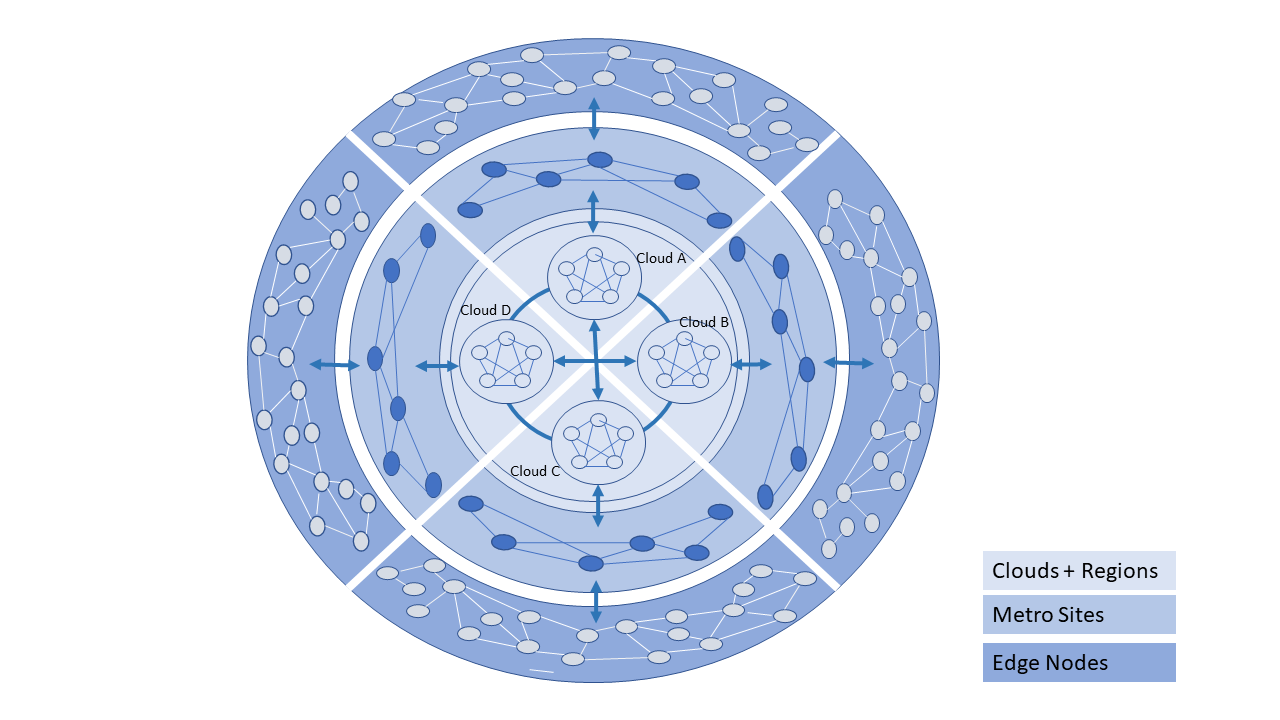Add to RM Ch03 as a sub-section of Introduction
Hybrid Multi-Cloud Enabled Edge Architecture
The GSMA whitepaper on "Operator Platform Concept Phase 1: Edge Cloud Computing" (January 2020) states, "Given the wide diversity of use cases that the operators will tasked to address, from healthcare to industrial IoT, it seems logical for operators to create a generic platform that can package the existing assets and capabilities (e.g., voice messaging, IP data services, billing, security, identity management, etc. ...) as well as the new ones that 5G makes available (e.g., Edge cloud, network slicing, etc.) in such a way as to create the necessary flexibility required by this new breed of enterprise customers."
Cloud computing has evolved and matured since 2010 when NIST (http://csrc.nist.gov/publications/nistpubs/800-145/SP800-145.pd) published its definition of cloud computing, with its 5 essential characteristics, 3 service models and 4 deployment models. The generic model for cloud computing types has to be "hybrid" as the special cases of purely private or public clouds are subsets of the generic hybrid cloud deployment model. In a hybrid cloud deployment, at least two or more distinct cloud infrastructures are connected together.
Cloud deployments can be created using a variety of open-source (e.g., OpenStack, Kubernetes) and commercial technologies (e.g., VMware). A multi-cloud deployment consists of the use of more than one technology.
A generic Telco cloud is an hybrid multi-cloud. In this section we will further explore the characteristics of the hybrid multi-cloud, architecture and architecture building blocks that constitute the hybrid multi-cloud.
- The Telco Operator may own and/or have partnerships and network connections to utilize multiple Clouds
- for network services, IT workloads, external subscribers
- On Prem Private
- Open source; Operator or Vendor deployed and managed | OpenStack or Kubernetes based
- Vendor developed; Operator or Vendor deployed and managed | Examples: Azure on Prem, VMWare, Packet, Nokia, Ericsson, etc.
- On Prem Public: Commercial Cloud service hosted at Operator location but for both Operator and Public use | Example: AWS Wavelength
- Outsourced Private: hosting outsourced; hosting can be at a Commercial Cloud Service | Examples: Equinix, AWS, etc.
- (Outsourced) Public: Commercial Cloud Service | Examples: AWS, Azure, VMWare, etc.
- Multiple different Clouds can be co-located in the same physical location and may share some of the physical infrastructure (for example, racks)
| Type | System Developer | System Maintenance | System Operated & Managed by | Location where Deployed | Primary Resource Consumption Models |
|---|---|---|---|---|---|
| Private (Internal Users) | Open Source | Self/Vendor | Self/Vendor | On Prem | Reserved, Dedicated |
| Private | Vendor | HCP | Self/Vendor | Self/Vendor | On Prem | Reserved, Dedicated |
| Public | Vendor | HCP | Self/Vendor | Self/Vendor | On Prem | Reserved, On Demand |
| Private | HCP | Vendor | Vendor | Vendor Locations | Reserved, Dedicated |
| Public (All Users) | HCP | Vendor | Vendor | Vendor Locations | On Demand, Reserved |
- Each Telco Cloud consists of multiple interconnected Regions
- A Telco Cloud Region may connect to multiple regions of another Telco Cloud (large capacity networks)
- A Telco Cloud also consists of interconnected local sites (multiple possible scenarios)
- A Telco Cloud's local site may connect to multiple Regions within that Telco Cloud or another Telco Cloud
- A Telco Cloud also consists of a large number of interconnected edge nodes
- Edge nodes may be impermanent
- A Telco Cloud's Edge node may connect to multiple local sites within that Telco Cloud or another Telco Cloud; an Edge node may rarely connect to an Telco Cloud Region


